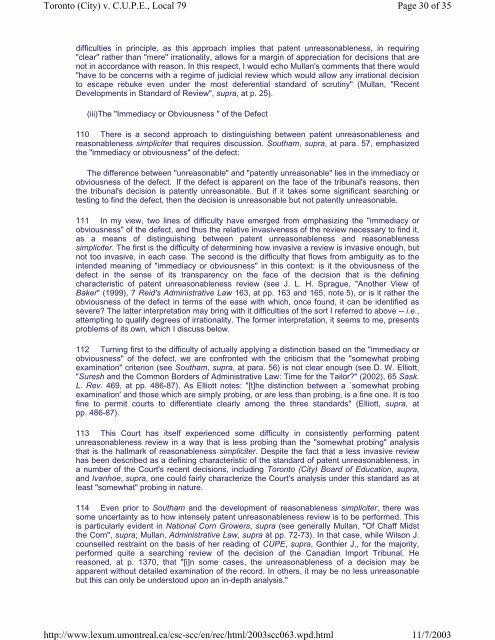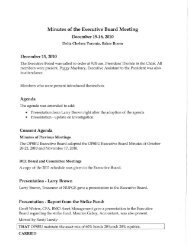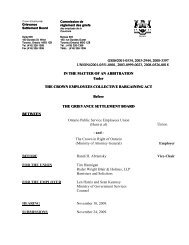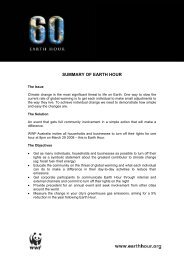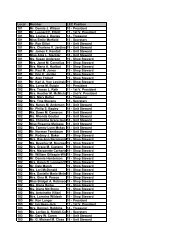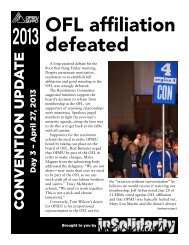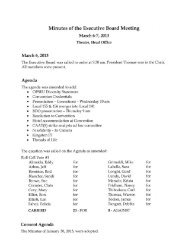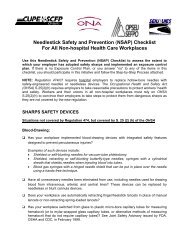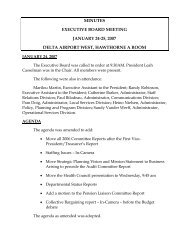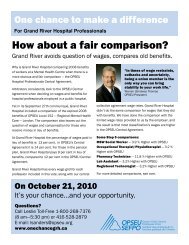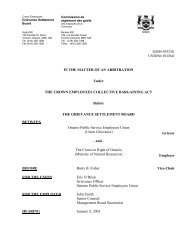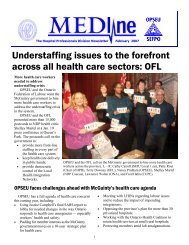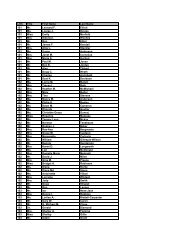C.U.P.E., Local 79 v. Toronto (City) .pdf - OPSEU
C.U.P.E., Local 79 v. Toronto (City) .pdf - OPSEU
C.U.P.E., Local 79 v. Toronto (City) .pdf - OPSEU
You also want an ePaper? Increase the reach of your titles
YUMPU automatically turns print PDFs into web optimized ePapers that Google loves.
<strong>Toronto</strong> (<strong>City</strong>) v. C.U.P.E., <strong>Local</strong> <strong>79</strong><br />
http://www.lexum.umontreal.ca/csc-scc/en/rec/html/2003scc063.wpd.html<br />
Page 30 of 35<br />
11/7/2003<br />
difficulties in principle, as this approach implies that patent unreasonableness, in requiring<br />
"clear" rather than "mere" irrationality, allows for a margin of appreciation for decisions that are<br />
not in accordance with reason. In this respect, I would echo Mullan's comments that there would<br />
"have to be concerns with a regime of judicial review which would allow any irrational decision<br />
to escape rebuke even under the most deferential standard of scrutiny" (Mullan, "Recent<br />
Developments in Standard of Review", supra, at p. 25).<br />
(iii)The "Immediacy or Obviousness " of the Defect<br />
110 There is a second approach to distinguishing between patent unreasonableness and<br />
reasonableness simpliciter that requires discussion. Southam, supra, at para. 57, emphasized<br />
the "immediacy or obviousness" of the defect:<br />
The difference between "unreasonable" and "patently unreasonable" lies in the immediacy or<br />
obviousness of the defect. If the defect is apparent on the face of the tribunal's reasons, then<br />
the tribunal's decision is patently unreasonable. But if it takes some significant searching or<br />
testing to find the defect, then the decision is unreasonable but not patently unreasonable.<br />
111 In my view, two lines of difficulty have emerged from emphasizing the "immediacy or<br />
obviousness" of the defect, and thus the relative invasiveness of the review necessary to find it,<br />
as a means of distinguishing between patent unreasonableness and reasonableness<br />
simpliciter. The first is the difficulty of determining how invasive a review is invasive enough, but<br />
not too invasive, in each case. The second is the difficulty that flows from ambiguity as to the<br />
intended meaning of "immediacy or obviousness" in this context: is it the obviousness of the<br />
defect in the sense of its transparency on the face of the decision that is the defining<br />
characteristic of patent unreasonableness review (see J. L. H. Sprague, "Another View of<br />
Baker" (1999), 7 Reid's Administrative Law 163, at pp. 163 and 165, note 5), or is it rather the<br />
obviousness of the defect in terms of the ease with which, once found, it can be identified as<br />
severe The latter interpretation may bring with it difficulties of the sort I referred to above -- i.e.,<br />
attempting to qualify degrees of irrationality. The former interpretation, it seems to me, presents<br />
problems of its own, which I discuss below.<br />
112 Turning first to the difficulty of actually applying a distinction based on the "immediacy or<br />
obviousness" of the defect, we are confronted with the criticism that the "somewhat probing<br />
examination" criterion (see Southam, supra, at para. 56) is not clear enough (see D. W. Elliott,<br />
"Suresh and the Common Borders of Administrative Law: Time for the Tailor" (2002), 65 Sask.<br />
L. Rev. 469, at pp. 486-87). As Elliott notes: "[t]he distinction between a `somewhat probing<br />
examination' and those which are simply probing, or are less than probing, is a fine one. It is too<br />
fine to permit courts to differentiate clearly among the three standards" (Elliott, supra, at<br />
pp. 486-87).<br />
113 This Court has itself experienced some difficulty in consistently performing patent<br />
unreasonableness review in a way that is less probing than the "somewhat probing" analysis<br />
that is the hallmark of reasonableness simpliciter. Despite the fact that a less invasive review<br />
has been described as a defining characteristic of the standard of patent unreasonableness, in<br />
a number of the Court's recent decisions, including <strong>Toronto</strong> (<strong>City</strong>) Board of Education, supra,<br />
and Ivanhoe, supra, one could fairly characterize the Court's analysis under this standard as at<br />
least "somewhat" probing in nature.<br />
114 Even prior to Southam and the development of reasonableness simpliciter, there was<br />
some uncertainty as to how intensely patent unreasonableness review is to be performed. This<br />
is particularly evident in National Corn Growers, supra (see generally Mullan, "Of Chaff Midst<br />
the Corn", supra; Mullan, Administrative Law, supra at pp. 72-73). In that case, while Wilson J.<br />
counselled restraint on the basis of her reading of CUPE, supra, Gonthier J., for the majority,<br />
performed quite a searching review of the decision of the Canadian Import Tribunal. He<br />
reasoned, at p. 1370, that "[i]n some cases, the unreasonableness of a decision may be<br />
apparent without detailed examination of the record. In others, it may be no less unreasonable<br />
but this can only be understood upon an in-depth analysis."


